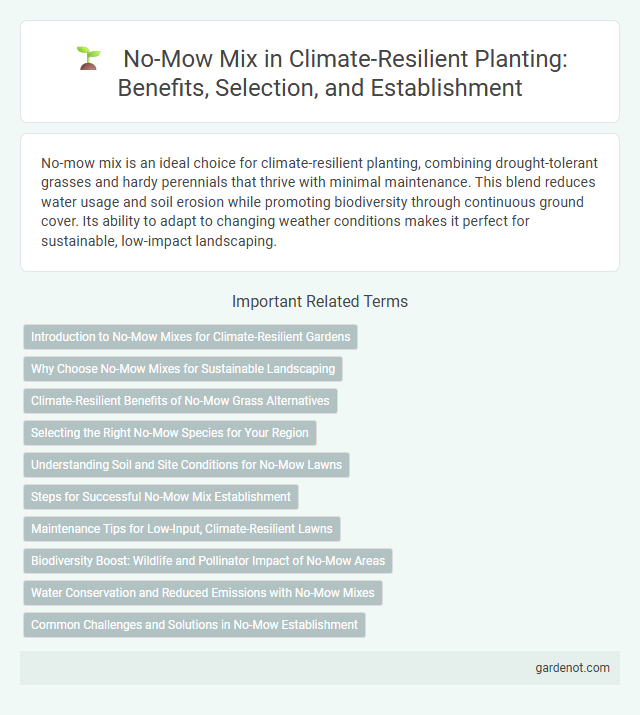No-mow mix is an ideal choice for climate-resilient planting, combining drought-tolerant grasses and hardy perennials that thrive with minimal maintenance. This blend reduces water usage and soil erosion while promoting biodiversity through continuous ground cover. Its ability to adapt to changing weather conditions makes it perfect for sustainable, low-impact landscaping.
Introduction to No-Mow Mixes for Climate-Resilient Gardens
No-mow mixes consist of low-growing, drought-tolerant grasses and native wildflowers that require minimal mowing and maintenance, enhancing garden resilience to climate variability. These mixes improve soil health through deep root systems, increase biodiversity by supporting pollinators and wildlife, and reduce water usage compared to traditional lawns. Implementing no-mow mixes helps create sustainable, climate-resilient gardens that adapt to extreme weather patterns and conserve natural resources.
Why Choose No-Mow Mixes for Sustainable Landscaping
No-mow mixes require minimal maintenance, significantly reducing water usage and carbon emissions associated with frequent mowing, making them an eco-friendly choice for sustainable landscaping. These mixes promote biodiversity by supporting diverse pollinators and soil microorganisms, enhancing ecosystem resilience against climate change. Their deep-rooted plants improve soil structure and water retention, mitigating erosion and adapting landscapes to shifting weather patterns.
Climate-Resilient Benefits of No-Mow Grass Alternatives
No-mow grass alternatives significantly enhance climate resilience by reducing water usage and minimizing maintenance emissions compared to traditional lawns. These mixes often include drought-tolerant species that improve soil health and support local biodiversity, contributing to ecosystem stability. Their deep-root systems increase carbon sequestration and mitigate soil erosion, promoting long-term environmental sustainability.
Selecting the Right No-Mow Species for Your Region
Selecting the right no-mow species for your region involves understanding local climate conditions and soil types to ensure optimal growth and resilience. Native grasses and wildflowers adapted to regional rainfall patterns and temperature ranges promote biodiversity while reducing maintenance needs. Incorporating drought-tolerant and deep-rooted species enhances soil health and water retention, making your no-mow mix more climate-resilient.
Understanding Soil and Site Conditions for No-Mow Lawns
No-mow mixes thrive best in well-drained soils with moderate fertility, avoiding compacted or waterlogged sites that hinder root development. Assessing soil pH, texture, and moisture retention is crucial to selecting appropriate native grasses and wildflowers that require minimal mowing and maintenance. Tailoring planting strategies to specific site conditions enhances drought tolerance and promotes sustainable, climate-resilient lawn ecosystems.
Steps for Successful No-Mow Mix Establishment
Selecting the appropriate no-mow mix with drought-tolerant and native species ensures climate resilience and minimal water needs. Preparing the soil by removing existing vegetation and ensuring good seed-to-soil contact significantly improves germination rates. Regular monitoring during establishment, combined with light watering in dry periods, supports robust root development and long-term survival.
Maintenance Tips for Low-Input, Climate-Resilient Lawns
No-mow mixes require minimal watering, reducing water usage by up to 50% compared to traditional lawns, which supports drought resilience. Mowing is infrequent, often only once or twice a year, helping to maintain soil health and prevent stress on deep-rooted native grasses and wildflowers. Regular monitoring for invasive weeds and occasional spot treatments ensure the mix remains healthy and sustainable in variable climate conditions.
Biodiversity Boost: Wildlife and Pollinator Impact of No-Mow Areas
No-mow mix planting significantly enhances biodiversity by providing critical habitats for wildlife and pollinators, supporting a diverse range of native insects, birds, and small mammals. These areas offer continuous flowering plants that supply essential nectar and pollen sources, promoting pollinator health and increasing ecosystem resilience. Reduced mowing frequency lowers habitat disturbance, allowing native species to thrive and contributing to long-term ecological balance in climate-resilient landscapes.
Water Conservation and Reduced Emissions with No-Mow Mixes
No-mow mixes utilize drought-tolerant grasses and native plants that significantly reduce water consumption by minimizing irrigation needs. These mixes lower carbon emissions by eliminating the need for gas-powered lawn equipment, thereby decreasing fossil fuel usage and air pollution. Integrating no-mow seed blends supports climate resilience by conserving water resources and reducing the overall carbon footprint of landscaping practices.
Common Challenges and Solutions in No-Mow Establishment
No-mow mix establishment often faces challenges such as slow germination rates and weed competition, which delay ground cover and reduce climate resilience. Proper site preparation, including soil testing and weed management, enhances seed-to-soil contact and improves germination success. Selecting native, drought-tolerant species within the no-mow mix promotes long-term sustainability and reduces maintenance demands in climate-resilient planting projects.
No-mow mix Infographic

 gardenot.com
gardenot.com